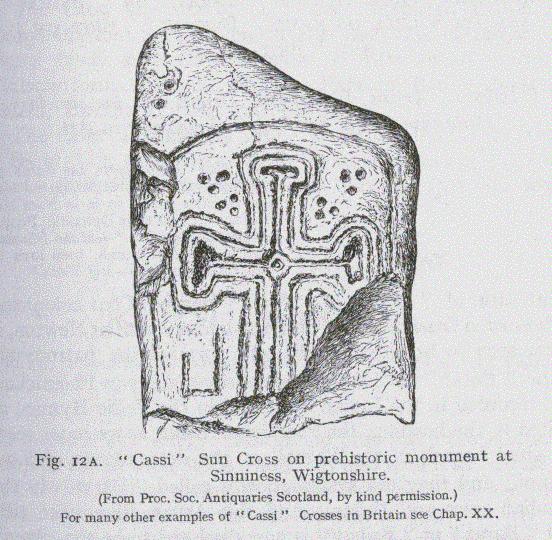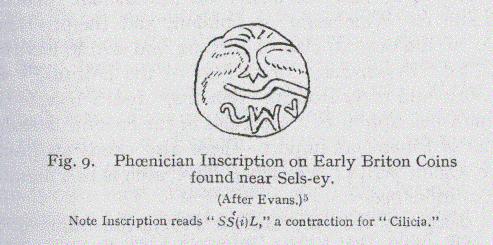
Fig. 9. Phoenician Inscription on Early Briton Coins found near Sels-ey.
(After Evans.)5
Note Inscription reads "SS(i)L," a contraction for "Cilicia."
"One of the few, the Immortal Names
That are not born to die."-F. HALLECK.
THE rich crop of personal, ethnic and geographical names recorded in these Newton Stone inscriptions of about 400 B.C. by their "Sun-worshipping" Phoenician-Briton author-whose personal appearance is illustrated in Fig.10, p.46-are of especial Phoenician significance. These names disclose, amongst other things, not only the Phoenician origin of the British Race, properly so-called, and their Civilization, but also the Phoenician origin of the names Brit-on, Brit-ain, Brit-ish, and of the tutelary name "Brit-annia." The patronymic origin of that title is seen in the Aryan tradition preserved by the eastern branch of the Barats in their epic cited in the heading on p. 52 as well as the old custom of the Aryan clans referred to in the Vedas1 to call themselves after their father's name. And King Barat, after whom this ruling clan called themselves, was the most famous forefather of the founder of the First Phoenician Dynasty, which event, I find by the new evidence, occurred about 3100 B.C., according to the still extant contemporary inscriptions.2
Whilst calling himself a "Phoenician" and giving his personal name, the author of this Newton Stone inscription
38
also calls himself by the title of Briton and Scot, and "Hittite," "Silurian" and "Cilician," by early forms of these names, and records as the place of his nativity a famous well-known old capital and centre of Sun-worship in Cilicia. We shall now identify these names and titles in this uniquely important historical British inscription in detail.
His title of "Phoenician" first calls for notice. Its spelling of "Poenig " in this inscription equates closely with the Greek and Roman and other still earlier forms of that title. Thus it is seen to equate with the "Phoinik-es" of the Greeks, the "Phonic-es" of the Romans, the Panag Panasa and Fenkha of the ancient Egyptians1 (which latter sea-going people are referred to in the records of the Fifth Dynasty of Egypt); the Panag of the Hebrews, and "The able Panch" of the Sanskrit Epics and Vedas. These different dialectic forms of spelling the name Phoenician thus give the equation:-
Newton Fgyptian. Hebrew. Sanskrit. Greek. Latin. English.
Stone.
Poenig = Panag = Panag = Panch(-ala) =Phoinik-es=Phoenic-es=Phoenic-ian
Panasa Punic-i Punic
Fenkha
The omission of this title in the Ogam version is obviously due to
want of space, as that cumbrous script had already overrun the edge of
the stone (its usual place) on to the face of the stone.
This title of "Poenig" or Phoenic-ion possibly survives locally at the Newton Stone in the name "Bennachie," for the bold mountain dominating the site of the monument, and celebrated along with the Gadie river in the old song already referred to. "Ben," of course, is the Cymric and Gaelic name for "mountain," but there seems no obvious Gaelic or Celtic suitable meaning for "Nachie" or "Achie." On the other hand, the letters P and B are always freely interchangeable dialectically, and as a fact "Phoenix" and "Phoenicos" were names for several mountains at Phoeni-
clan sites, such as in Caria (an early Phoenician colony) and in Lycia adjoining Cilicia, and in Boeotia in Greece.1 It thus seems not impossible that Bennachie mountain may preserve the title of the famous "Poenig" king who first civilized this part of Britain and erected his votive pillar at its foot, and who presumably was buried beside it under the shadow of the beautiful Bennachie. Or there may have been a Sun-altar on its topmost peak or at its base, dedicated by this Phoenician king or his descendants to the "Phoenix" Sun-bird emblem of Bil or Bel. (See later).
In this regard also, the name of "Bleezes" for the old inn at the foot of Mt. Bennachie (now a farm house) is suggestive of former Bel Fire worship here. "Bleezes," "Blaze," Blayse, or Blaise, was the name of a canonical saint introduced into the Early Christian Church in the fourth century, from Cappadocia, like St. George,2 and, like the latter, has no authentic historical Christian original, but is evidently a mythical incorporation of the Bel Fire cult introduced for proselytizing purposes. He was made the patron-saint of Candlemas Day, 2nd (or 3rd) February-the solar festival of end of winter and beginning of spring, mid-way between Yule or Old-time Christmas, the end of the solar year and the spring equinox; it is still the common name for the beginning of the Scottish fiscal year.3 He is represented in art as carrying "a lighted taper, typical of his being a burning and a shining light."4 So popular was his worship in Britain in the Middle Ages that the Council of Oxford in 1222 prohibited secular labour on that day.5 It was till lately the custom in many parts of England to light bonfires on the hills on St. Blazes' night.6 Norwich still observes his day, and at Bradford in Yorkshire a festival is held every five years in honour of St. Blaze.7 He was specially associated with the text in Job V.23 "thou shalt be in league
with the Stones of the Field,1" which is perhaps a reference to the sacred stones of natural boulders, such as were used in the Bel Fire cult; so that this local name of "Bleezes," under Bennachie and in sight of our monument, may preserve the tradition of an ancient Phoenician altar blazing with perpetual Fire-offering to Bel.
His title of "Cilician" occurs in two forms of spelling. In the Phoenician script it is spelt "Sssilokoy," and in the Ogam, which possesses fewer alphabetic letters, it is written "Siollagga." This clearly designates the "Cilicia" of the Romans, the "Kilikia" of the Greeks and the "Xilakku" or "Xilakki" of the Babylonians,2 the maritime province of eastern Asia Minor bordering the north-east corner of the Mediterranean (see map). Situated on the land-bridge connecting Asia Minor and the west with Syria-Phoenicia, Egypt, Mesopotamia and the east, and of great strategical importance, it was early occupied by the Phoenicians, and contained one of their early seaports, namely Tarsus, the "Tarshish"3 of the Hebrew Old Testament, famous for its ships. That city-port was also significantly named "Parthenia"4 or "Land of the Parths," that is, as now seen, a dialectic variant of the Phoenician eponym "Barat," in series with the "Prat" on our Newton monument.5 Significantly also it was an especial centre of Bel worship, and was under the special protection of the marine tutelary goddess Barati who was, as we shall see, the Phoenician prototype of our modern British tutelary "Britannia."
So intimately, indeed, were the Phoenicians identified with Cilicia, that later classic Greek writers, when the exact relationship of Cilicia to the Phoenicians had become forgotten, still make the Cilicians to be "the brothers" of the Phoenicians. Phoenix and King Cadmus-the-Phoenician
are called the sons of Agenor, the first traditional king of the Phoenicians, and their brother was Kilix,1 that is the eponym of Cilicia, the "Kilikia" of the Greeks. And the ancient Phoenician colonists from Cilicia proudly recorded their Cilician ancestry, like the author of our monument, and like the apostle Paul who boasted, saying "I am a Jew of Tarsus, a city of Cilicia, a citizen of no mean city."2 They thus not infrequently recorded their "Cilician" ancestry on their sacred monuments and tombstones in foreign colonies3, but also transplanted their cherished name "Cilicia" to some of their new colonies.
Cilician colonists, like the author of our Newton inscription, were in the habit of not returning to their native land, Strabo tells us;4 and patriotically they sometimes transplanted their homeland name of "Cilicia" to their new colonies. Thus they name one of their colonies on the AEgean seaboard of the Troad, south of Troy, "Cilicia."5 This now leads us to the further discovery of an early-Phoenician Cilician seaport colony in South Britain, at Sels-ey or
"Island of the Sels."1 A hoard of pre-Roman coins of Ancient Britain, mostly gold, were found on the sea-shore between Bognor and Selsey, the latter being the name of the ancient Briton sea-port town of the peninsula offlying the Briton "Caer Cei" city, the Chichester of the Romans.2 These coins are of archaic type with solar symbols (see later) and bear an inscription hitherto undeciphered, and described by the leading numismatist as "a number of marks something like Hebrew characters, which is, however, indecipherable."3
Now, this inscription on these Ancient Briton coins from Selsey (see Fig. 9) is, I find, stamped in clear Aryan Phoenician writing, with letters generally similar to those of the Newton Stone, and, like it, reads, in the usual Aryan or non-Semitic direction.4 It reads "SS(i)L," which seems a contraction

for the fuller "Sssilokoy" or "Cilicia" of the Newton Stone Phoenician inscription; for it is the rule in Early Briton coins, also followed in modern British, to use a contracted form of place and other names for want of space. Topographically, this Sels-ey was precisely the sort of island
or peninsula, offlying the mainland marts, as at Tyre, Sidon, Gadesh, St. Michael's Mount, etc., which the Phoenician sea-merchants were in the habit of selecting, for defensive purposes, as a mercantile seaport, before they established themselves on the mainland. And its name on these coins implies that the Phoenicians at that old city-state here had a mint established for the issue of these coins. That old city is unfortunately now, through subsidence of the coast, submerged in the channel.1 On the adjoining mainland, a few miles from Sels-ey, stands the old pre-Roman city-port of Chichester (with an ancient Briton-paved highway to London called "Stane Street"), with prehistoric earthworks and remains of prehistoric villages and Bronze Age implements2 implying early habitation. And at Sil-Chester to the north of Sels-ey and Chichester on the ancient road from Chichester via Winchester to London, and the pre-Roman capital of the Segonti clan of Britons, and said to have been also called "Briten-den" or "Fort of the Britons,"3 with prehistoric and early Iron Age remains,4 and a temple with a Roman inscription to "Hercules of the Segonti Britons"5 --a fact of Phoenician import--there also exists an inscription in Ogam script,6 which we have seen is of Phoenician origin or influence.
This discovery that the ancient Phoenician origin of the name of Sels-ey or "Island of the Sels or Ciliclans," now suggests that the name "Sles-wick" or "Abode of the Sles," for the home of the Angles in Denmark, presumably also represents this softened dialectic form of the name "Cilicia" in series with that on the Newton Stone and the Sels-ey coins, and thus appears to indicate the foundation of Sles-wick by a colony of Phoenicians from Cilicia. The "Silik" form of "Cilicia" of the Phoenicians seems also to be probably the source of the "Selg-ovae" tribal title, which was applied by the Romans to the people of the Galloway
coast of the Solway, who seem to have been the same warlike tribe elsewhere called by the Romans "Atte-Cotti," which, we shall see, is obviously a tautological dialectic form of "Catti" or "Atti" or Hitt-ite. The substitution of the soft sibilant C, with the sound of S for the hard K, is seen in the Roman spelling of "Cilicia" for the Greek "Kilikia" and in "Celt" for the earlier Kelt, as well as in the modern "Cinema" for "Kinema," etc. Now we resume our examination of the further significant titles borne by this Cilician Phoenician upon his votive monument at Newton.
His "Kast" (or "Kwast") title also is clearly a geographical one. It designates him as a native of the famous Kasta-bala, a sacred Cilician city1 and the ancient capital of Cilicia about 400 B.C., that is at the actual period of the Cilician Phoenician author of this monument at Newton.
Kastabala on the Pyramus River of Eastern Cilicia (see Map), and commanding the caravan trade-route to Armenia, Persia, Central Asia and the East, and the route by which Marco Polo travelled overland to Cathay,2 was still the capital of Eastern Cilicia at the occupation of Asia Minor by the Romans in 64 B.C., who confirmed its Hitto-Syrian king Tarcondimo and his dynasty in the sovereignty. On account of its sacred ancient shrine (where Diana was called Perathea3 who, we shall find, was "Britannia,") it was called Hieropolis or "Sacred City" by the Seleucid emperor, Antiochus IV., about 175 B.C.,4 which name occurs on its coin; and other documents from that date onwards; and some of its coins figure its deity carrying a Fire-torch,5 implying the solar Fire-cult, and others bear an anchor as evidence of its sea-faring trade.6 Moreover, the upper valley of the Pyramus, above Kastabala, was called by the Greco-Romans "Kata-onia" or "Cata-onia," that is, "Land of the Kat or Cat," which title, we shall see,
is a dialectic form of "Catti," the title of the Ancient Britons as found stamped on their coins, and a title of the Phoenician Barat rulers.
This identification of the Kast of our inscription with Kastabala in Cilicia now gives us the clue not only to the Cilician source of the Sun-cult imported into North Britain by this Phoenician Barat prince, but it also supplies a clue to his own personal appearance and dress. Amongst the remains of the Sun-cult monuments in ancient Cilicia, which was a chief centre for the diffusion of the Sun-cult of "Mithra"
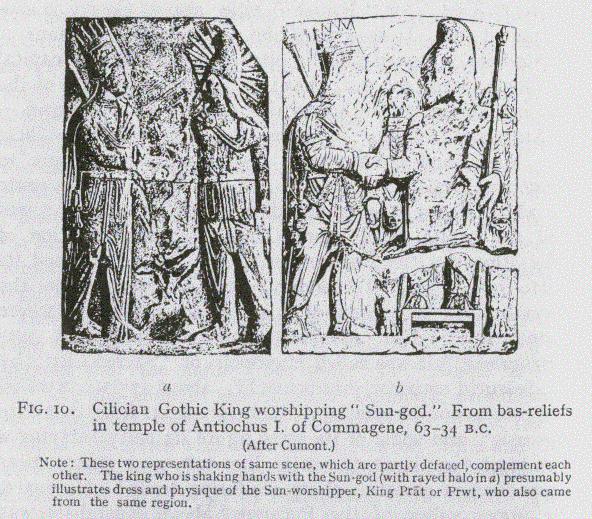
in Roman Europe through the Roman legionaries stationed there,1 are in Upper Cilicia two bas-reliefs from the Sun-temple of King Antiochus I. of Commagene, on the Upper Pyramus, 63-34. B.C. (see Fig. 10).2 In these, which represent
the same scene, the king is seen shaking hands by the right hand with the image of the Father-God of the Sun, as part of the old Sumerian ceremony of coronation, when the solar kings assumed the title of "Son of the Sun-god," a title also adopted from the Aryans by the pharaoh of Egypt. This ancient Sumerian ceremonial seems referred to in the Vedic hymn to the Sun-god Mitra which says
"When will ye (Mitra) take us by both bands, as a dear sire his son?"1.And even more significantly it was evidently practised by the Goths in Ancient Britain, as recorded in the Eddas:
"The Sun wrapped its sunshine o'er the assembly of men,In this way, as our Barat king, in his votive inscription to the Sun-god at Newton, tells us that he was a native of this region, he presumably resembled this king generally in dress and physique. Thus king, it will be noticed, is attired in Gothic dress, and the Sun-god with the rayed halo (a in Fig.) wears the Gothic or Phrygian cap, and is also clad in Gothic dress.
His Right hand (was) caught in the House of Heaven."2
His "Kazzi" or "Qass" title is clearly and unequivocally a variant dialectic spelling of "Kasi," an alternative clan title of the Phoenician Khatti Barats.
[z is a frequent dialectic variant in spelling s; for example, the Hebrews spelt "Sidon" and "Sion" as "Zidon" and "Zion"; and Q is habitually used for K in the Ogam, which does not possess the letter K. And Tarsus in Cilicia was spelt Tarz.]
Kasi was an eponym title adopted, we find, by some of the early Aryan Phoenician Barats and their successors, from the name of a famous grandson of King Barat, named Kas, or Kas. It is applied in the Vedas to one or more kings of the First Panch(-ala) Dynasty, as well as in the Indian Epic King-Lists, some of which apply it to the whole of that dynasty as well as to their descendants. And on arrival in India, the Kasi Dynasty, significant of their maritime sway,
held the river-way up the Ganges, at their capital of Kasi, the modern Benares, bordering the Panch(-ala) province of Ancient India.
"Kassi" (or "Cassi") was the title used by the First Phoenician Dynasty about 3000 B.C., as attested in their still extant inscriptions.1 It was the title adopted by the great dynasty of that name in Babylonia which ruled the Mesopotamian empire for about six centuries, from about 1800 B.C., and who are now generally admitted to have been Aryans. And Kasi also occurs as a personal name of Phoenicians in inscriptions in Egypt.2
This Kasi title is thus now disclosed as the Phoenician source of the "Cassi" title borne by the ruling Briton Catti kings of pre-Roman Britain down to Cassivellaunus (see later), who minted the "Cas" coins bearing the Sun-horse and other solar symbols (see Fig. 11).
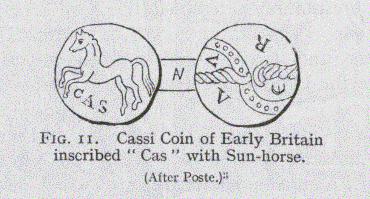
The Early Aryan Kasi are referred to in Vedic literature as offerers of the sacred Fire and the especial proteges of Indra. And in Babylonia the Kassi were ardent "Sun-worshippers" with its Fire offering; and were devotees of the Sun Cross, which is very freely represented on their sacred seals and monuments, in the various forms of St. George's Cross, the Maltese Cross (see Figs., Chap. XX). This fact is well seen in the engraving on the sacred official seal-
cylinder here reproduced (see Fig. 12). This shows the pious Aryan Cassis of Babylonia about 1350 B.C. ploughing and sowing under the Sign of the Cross, which, we shall find later, was their emblem of the Aryan Father-God of the Universe, as the Universal Victor.
This now explains for the first time the hitherto unaccountable fact of the "prehistoric" existence of the Cross, which is sculptured on this Newton Stone and on the many still surviving pre-Christian monuments with solar emblems in the British Isles, as we shall see later; and also the Cross symbol with other solar emblems on the pre-Roman coins of the Catti and Cassi kings of Early Britain. It also now
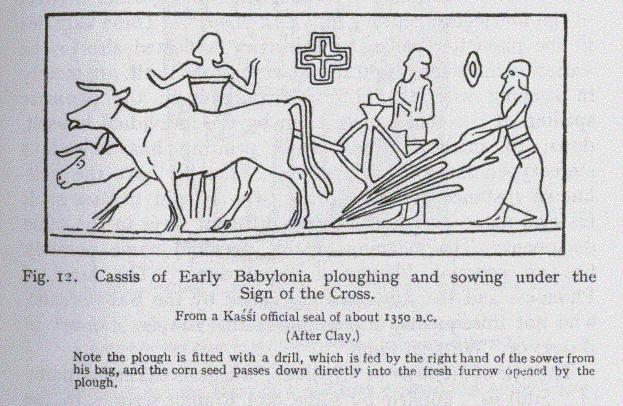
explains the "Cassi" title used by these pre-Roman Briton kings-a title in series with "Ecossais" for "Scot," as seen later-as well as the "Kazzi" and "Qass" title of the Phoenician author of this votive Cross at Newton and his Aryan racial origin. It also illustrates the fact, as we shall find later, that husbandry, with the settled life, formed the basis of the Higher Civilization of the Aryans, as the Aryans were the introducers of the Agricultural Stage in the World's Civilization. Indeed, so obviously "Aryan" was the language of
these Kassis of Babylonia, that most modern Assyriologists now admit that the Kassis were Aryan in race as well as speech. But yet, although Assyriologists mostly admit that these Kassis were apparently affiliated to the Khatti or Hittites, they nevertheless refuse the logical inference that the latter also were presumably Aryans.
His personal name "Ikhar," "Ixar," or "Icar," also significantly confirms his royal Kassi ancestry. This name was borne not infrequently by Kassis of Babylonia in their still extant legal and business documents, etc., of the second millennium B.C. It occurs therein in the varying dialectic spelt forms of Ikhar or Ixar, Ikhur, Ikkaria, Igar, Akhri, Agar, Agri, Ekarra, and Ekur1; and amongst the Hittites of the fourteenth century B.C., as "Agar."2 These vagaries in the phonetic spelling of the name, reflected also in the variation in spelling it on the Newton Stone itself, are merely in keeping with the notorious vagaries in the phonetic spelling of personal names, even by the individual himself, down to modern times, until printing has nowadays stereotyped the form of spelling. Thus we have the well- known instance of Shakespeare, who is said to have spelt his own name over half a dozen different ways in the same document. The meaning of this personal name possibly has an especial Phoenician significance. The land of Phoenicia and the Amorites was called by the Babylonians, who not infrequently interchanged the vowels, Akharri or Axarri or "Western Land."'
The title of S(i)luyri or "S(i)lwor," suggests the ethnic name of "Silur-es" applied by some late Roman writers to the people of South Wales bordering the Severn. But these Silures, described by Tacitus as dark-complexioned and Iberian,4 were clearly non-Aryan; and there is no suggestion in the Ancient British Chronicles to connect the author of these inscriptions with Wales. This title, therefore, is probably the designation of his subclan; though it may possibly
designate a Silurus district in Spain,1 from which country he is traditionally reported to have come immediately, as we shall see, on his way to Britain.
His further titles of "Prat" or "Prwt" and "Gyaolownie," or "Gioln" are of such great historical significance as to require a separate chapter.
